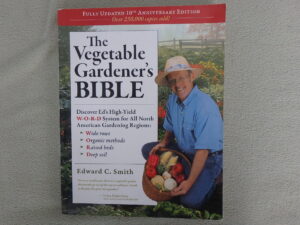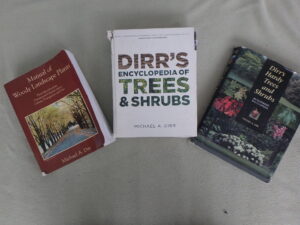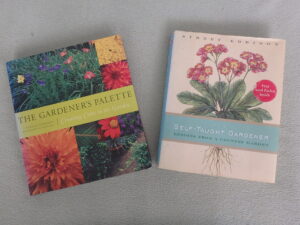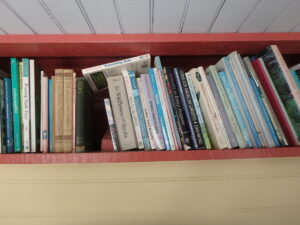Some years ago I taught a class in sustainable gardening at Granite State College, part of the University of New Hampshire system. I asked my students to buy The Garden Primer by Barbara Damrosch. This paperback is a compact 800-pages of readable, educational information about nearly every aspect of gardening. It came in out on 2008, but is still in print. Everyone could benefit by owning it.

For a book on vegetable gardening there is none better than Vermont’s own Ed Smith’s The Vegetable Gardener’s Bible. With more than a million copies sold, this book goes into detail on every veggie you could grow – when and how to plant, how long seeds last, when to harvest, and much more.
For the serious flower gardener or landscape professional I would recommend an 1,100 page book by Allan M. Armitage. His Herbaceous Perennial Plants: A Treatise on their Identification, Culture, and Garden Attributes. This book came out in 1989 and it is now its fourth edition, which came out in 2020. My goal for the winter is to read it, or the relevant parts, cover to cover. Why? Because I can learn from a man who is not only a PhD professor, but a hands-on gardener of many decades.

Are you interested in flower gardening? My first choice of books would be Tracy DiSabato-Aust’s book, The Well-Tended Perennial Garden: Planting & Pruning Techniques. She is obviously a well-experienced gardener and designer, and one who has learned to get her flowers to re-bloom, or bloom at a shorter height, and who knows how much sun and water each needs. Staking? Dividing plants? It’s all there and more.
There are plants in the book that I absolutely lust for. Unusual plants that will fill niches in my diverse garden beds. It also tells me why some plants I have tried have died out. It informs me about named varieties to look for that have special attributes.
Dr. Armitage is opinionated and often funny. I like that. It has some photos, but certainly not one for every flower mentioned. This is not a coffee table book, but a book for plant collectors, landscapers – and fanatics. At just under $80, I think it’s a bargain.

Trees? The most prolific and best informed expert, in my opinion, is Michael Dirr. I use his Manual of Woody Landscape Plants: Their Identification, Ornamental Characteristics, Culture, Propagation and Uses every week of the year. It has informed me about any tree or shrub I want to know about. Now in its 6th edition, it sells new for $81.80, but it is available used for much less (usually earlier editions).
Professor Dirr also has written many other books, several of them with terrific color photos (in contrast to his Manual, described above, which has only drawings). I spent one winter going through his Dirr’s Encyclopedia of Trees and Shrubs with its descriptions of 3700 species and cultivars and 3,500 photos.
Pruning is key to keeping your woody plants looking good. My favorite pruning book is by Lee Reich, The Pruning Book. With both diagrams and photographs, this book covers many species and their specific needs. His book, Grow Fruit Naturally is another excellent book you might want.
Soil is the key to good gardening, but a topic that is usually boring and scientifically described. Want at easy explanation of how it works? Try a book by Dianne Miessler, Grow Your Soil: Harness the Power of the Soil Food Web to Create Your Best Garden Ever. It explains very well how soils work, what soil test results mean, and how to correct deficiencies. You don’t need to be a scientist to read this one. ($16.95 in paper).
Stone is a key element in many gardens, part of the “bones” of a garden. Dan Snow, a Vermont dry stonewaller and stone artist, has written a number of fine books on using stone. Listening to Stone and In the Company of Stone both offer practical and philosophical advice and share many fine photos of his projects.
Gordon Hayward, a Vermont landscape designer and prolific author also has an excellent book on how to use stone, Stone in the Garden: Inspiring Designs and Practical Projects. Want to build a stone path or a retaining wall? Hayward simplifies the process. As with Dan Snow’s books, great photographs full of ideas.

Sydney Eddison is another prolific garden writer with many fine titles. Her The Gardener’s Palette: Creating Color in the Garden taught me a lot about the use of colors in the garden. Her advice is always practical and nicely explained.
So invest in some books this winter, curl up in a comfy place and see what you can learn that will help you, come spring.
Henry is the author of 4 gardening books including
Organic Gardening (not just) in the Northeast: A Hands-On, Month-by-Month Guide. It is a collection of his gardening articles gleaned from 10 years of writing. It has recently been re-printed and is available from Henry for $19. He is at PO Box 364, Cornish Flat, NH 03746. His email is
henry.homeyer@comcast.net.







